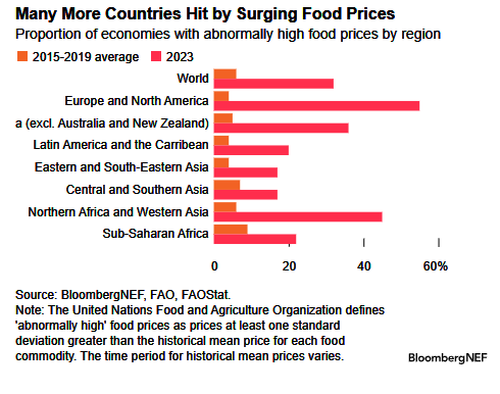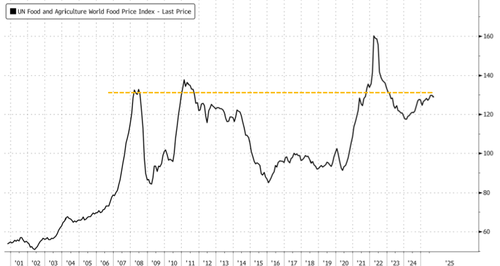A Third Of Countries Plagued by “Abnormally High” Food Prices – Brings Risks Of Social Unrest
The UN’s Food and Agriculture Organization (FAO) highlights in a new report that high food prices continue to persist worldwide, citing data that shows a fivefold increase across many countries. This exponential rise makes conditions ripe for social unrest, particularly in developing or politically fragile countries. We’ve seen this story before – from the Arab Spring to the 2007-08 food crisis – and this is a reminder that global turmoil is far from over.
BloombergNEF analyzed FAO data that highlighted adverse weather conditions in many of the world’s top farm belts, resulting in declining harvest yields. Additionally, geopolitical tensions drove up diesel and gasoline prices, exerting a broader inflationary impact on production costs. Additionally, the global phenomenon of excessive money printing has been the primary driver of inflation.
FAO indicates that 50% of countries in North America and Europe experienced abnormally high food prices in 2023, when compared to the average between 2015 and 2019. FAO defines “abnormally high” as at least one standard deviation greater than the average historical price of a given commodity in each region, as per Bloomberg.
Elevated FAO food prices globally, especially for developing or politically fragile nations, could make conditions ripe for social unrest.
Here’s the most recent historical precedent:
-
Arab Spring (2010–2011): A sharp rise in global wheat and bread prices following droughts and export bans in Russia helped ignite protests across Tunisia, Egypt, Libya, and Syria. Food price inflation was a key stressor that merged with political grievances.
-
2007–2008 Food Crisis: Spikes in global grain prices led to riots in more than 30 countries, including Haiti, Bangladesh, Egypt, and Mozambique, where basic staples became unaffordable for large segments of the population.
What’s clear is that when food inflation outpaces income growth, that begins the countdown clock of when social instabilities emerge.
Tyler Durden
Mon, 10/06/2025 – 13:55ZeroHedge NewsRead More







 T1
T1


